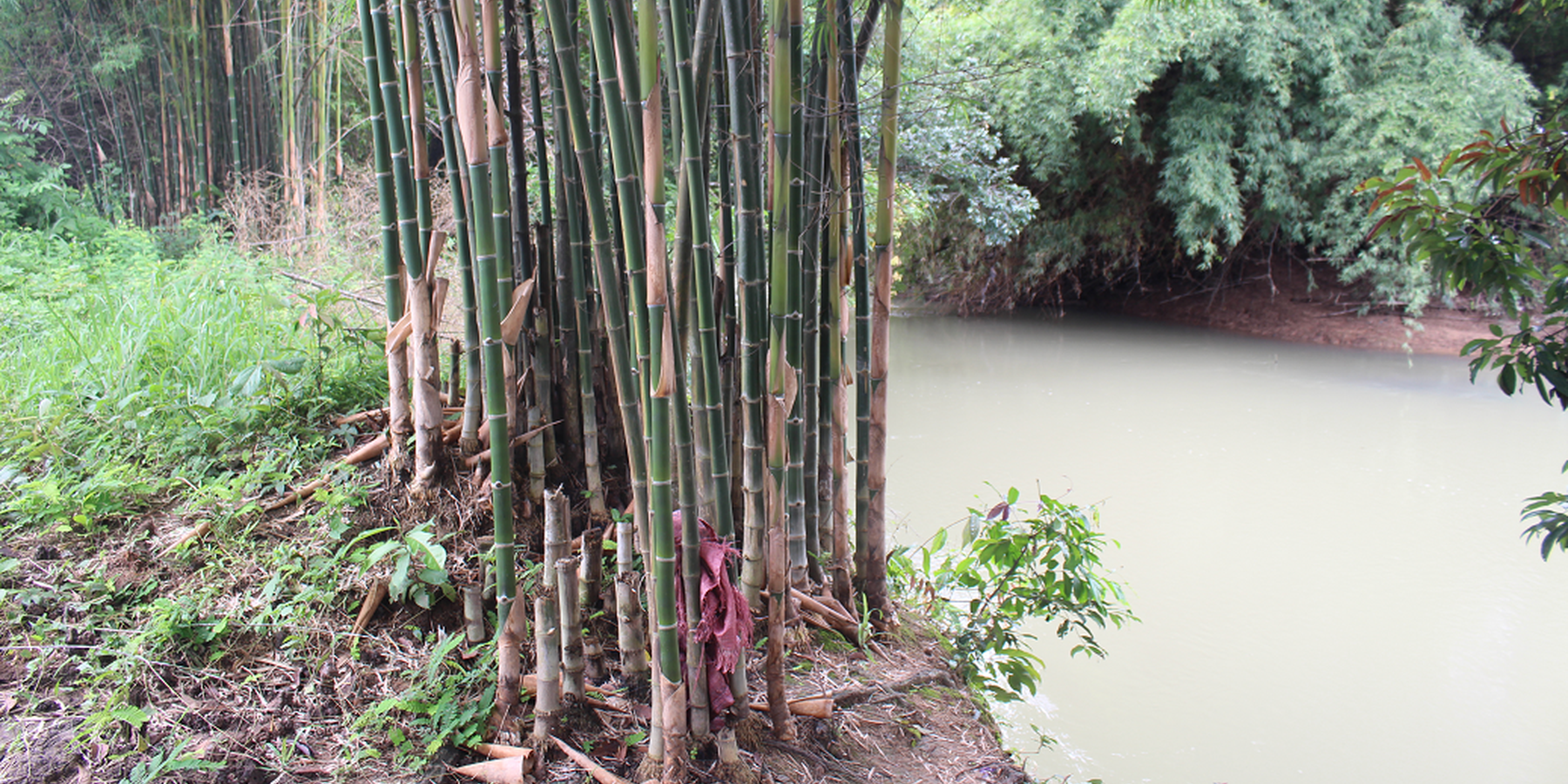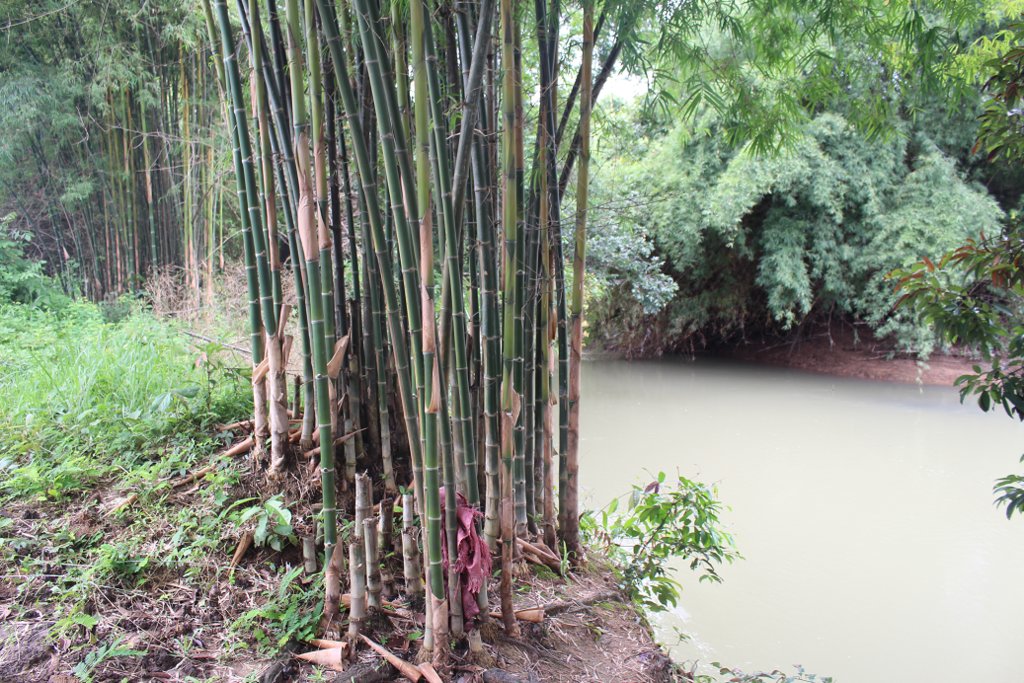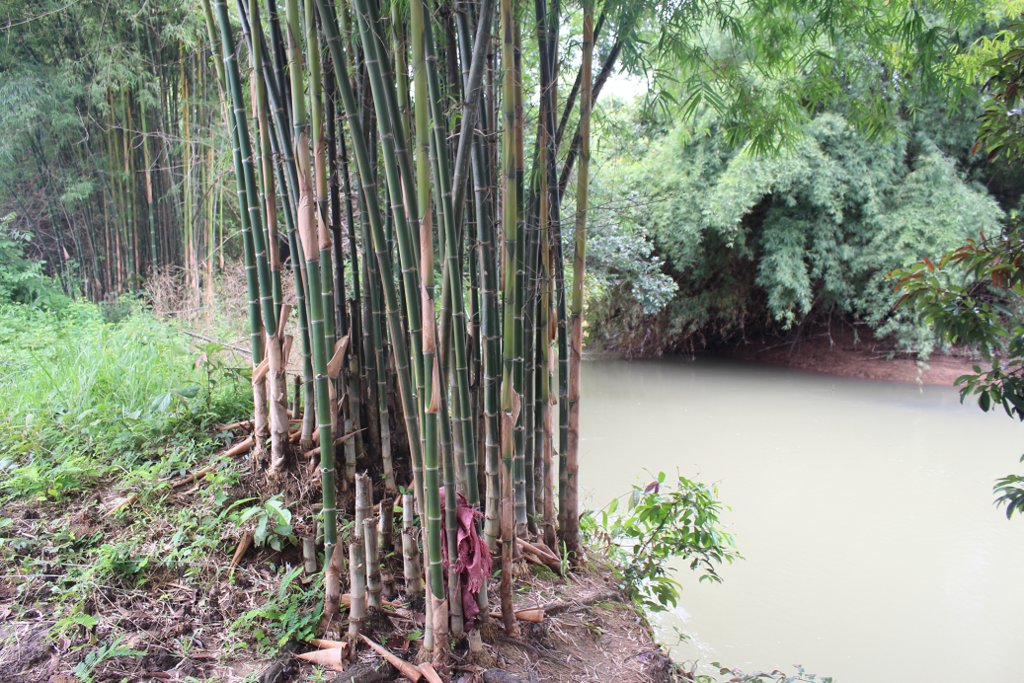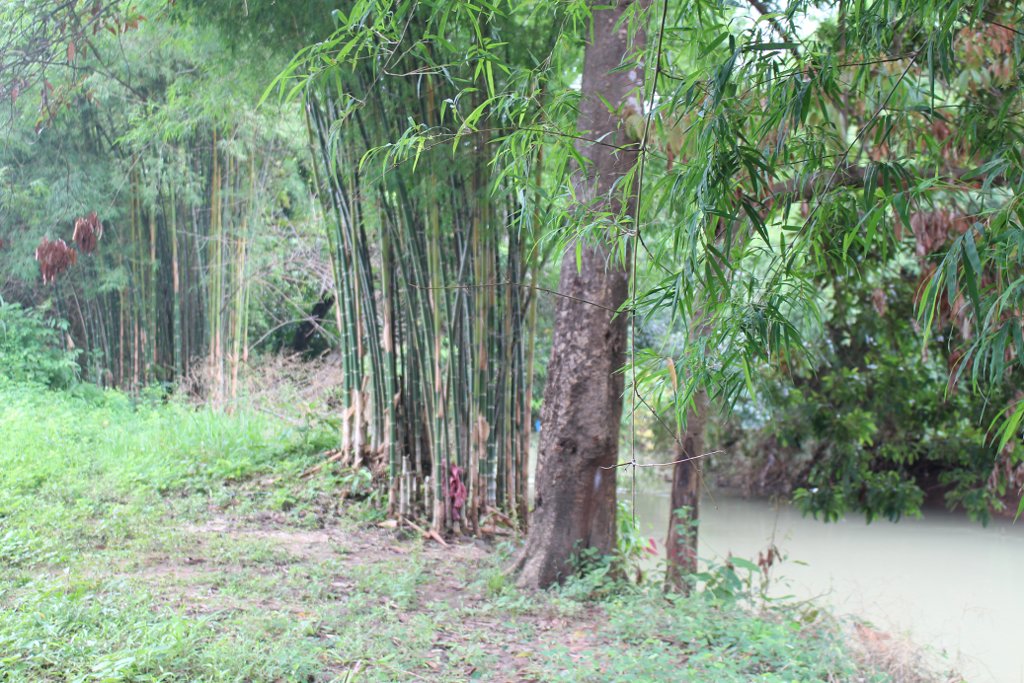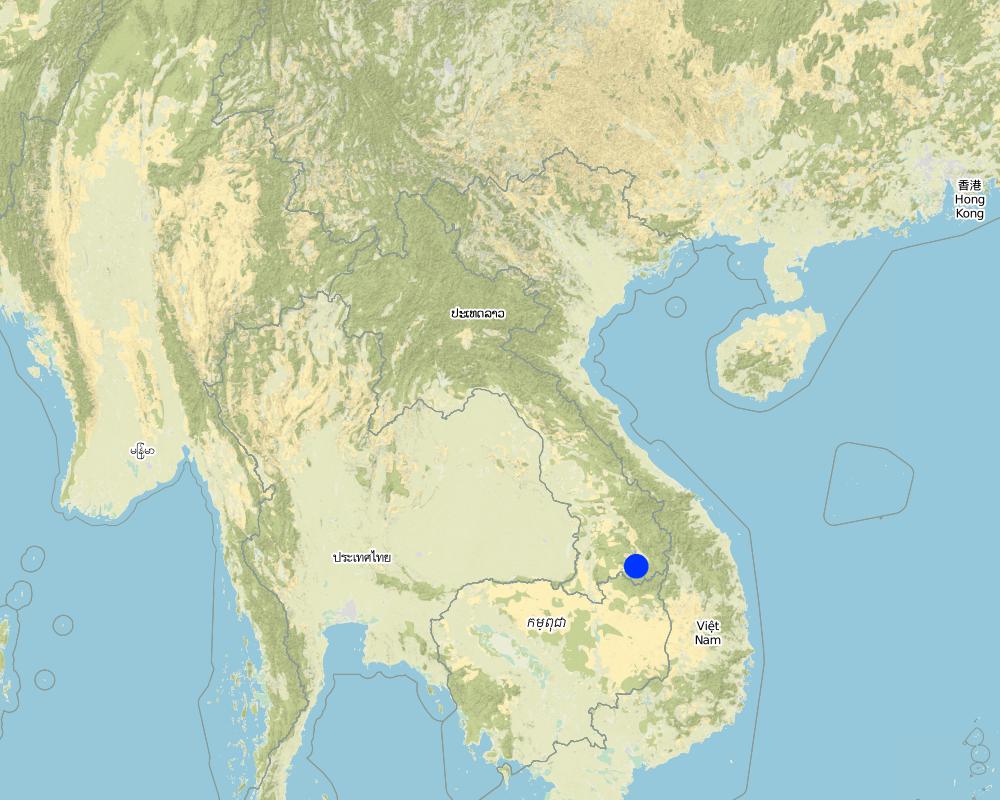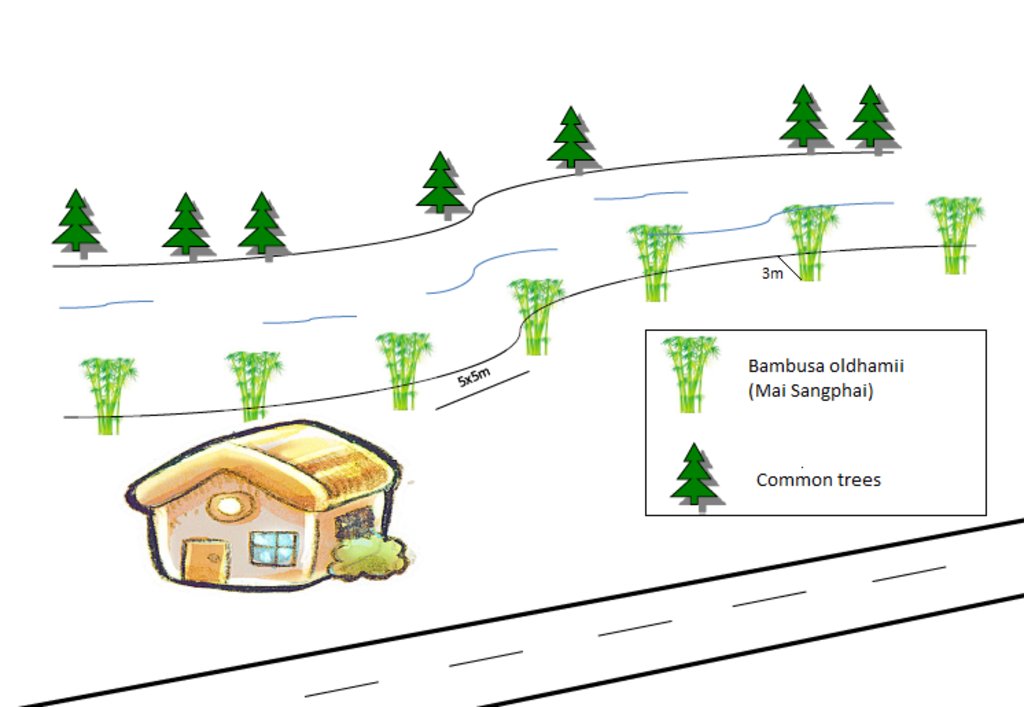ເຕັກນິກການປູກໄມ້ໄຜ່ ເພື່ອປ້ອງກັນດິນເຈື່ອນ [Lao People's Democratic Republic]
- Creation:
- Update:
- Compiler: kang phanvongsa
- Editors: kang phanvongsa, anousit namsena, Pasalath Khounsy, Bounthanom Bouahom, Chanvilay phalivong
- Reviewers: viengsavanh phimphachanhvongsod, Nicole Harari, Stephanie Jaquet
ເຕັກນິກການປູກໄມ້ໄຜ່ ເພື່ອປ້ອງກັນດິນເຈື່ອນ
technologies_2251 - Lao People's Democratic Republic
View sections
Expand all Collapse all1. General information
1.2 Contact details of resource persons and institutions involved in the assessment and documentation of the Technology
Key resource person(s)
land user:
ກຸນທິສັກ ທ້າວ. ຈັນສະໄຫມ
02055948049
ບ້ານ ວົງສຳພັນ, ເມືອງພູວົງ ແຂວງ ອັດຕະປື
Lao People's Democratic Republic
Name of project which facilitated the documentation/ evaluation of the Technology (if relevant)
Scaling-up SLM practices by smallholder farmers (IFAD)Name of the institution(s) which facilitated the documentation/ evaluation of the Technology (if relevant)
National Agriculture and Forestry Research Institute (NAFRI) - Lao People's Democratic Republic1.3 Conditions regarding the use of data documented through WOCAT
When were the data compiled (in the field)?
16/05/2017
The compiler and key resource person(s) accept the conditions regarding the use of data documented through WOCAT:
Ja
1.4 Declaration on sustainability of the described Technology
Is the Technology described here problematic with regard to land degradation, so that it cannot be declared a sustainable land management technology?
Nee
2. Description of the SLM Technology
2.1 Short description of the Technology
Definition of the Technology:
ເຕັກນິກ ປູກໄມ້ສ້າງໄພ ເພື່ອປ້ອງກັນ ການເຊາະເຈື່ອນຂອງດິນ ລຽບຕາມແຄມນ້ຳຫ້ວຍເພາະຮາກຂອງຕົ້ນໄຜຍາວ ສາມາດຍnດເກາະດິນ ເນື່ອ ງຈາກໃນຊ່ວງລະດູຝົນເຮັດໃຫ້ນ້ຳຫ້ວຍ ມີລະດັບນ້ຳສູງຂື້ນ ແລະ ໄຫຼແຮງ ສົ່ງຜົນເຮັດໃຫ້ຕາຝັ່ງແຄມນ້ຳເຊາະເຈື່ອນ
2.2 Detailed description of the Technology
Description:
ໃນຊ່ວງລະດູຝົນ ເມື່ອລະດັບນ້ໍາເພີ່ມສູງ ແລະ ຄວາມໄວຂອງການໄຫລຂອງນ້ໍາແຮງ, ໄມ້ສ້າງໄຜ່ (Bambusa oldhamii ) ໄດ້ຖືກຄັດເລືອກ ທີ່ຈະປູກຕາມແຄມນ້ຳ ແມ່ນ ຍ້ອນລະບົບຮາກເລິກເຊິ່ງມີປະສິດທິພາບ ໃນການເກາະດິນ ໂດຍສະເພາະຄວບຄຸມການເຊາະເຈື່ອນດິນຕາມແຄມແມ່ນ້ໍາ.ນັບຕັ້ງແຕ່ເດືອນ 7-10 ຢູ່ທີ່ບ້ານ ວັງຍາງ ( ເມືອງ ພູວົງ, ແຂວງອັດຕະປື ) ມັກຈະມີຝົນຕົກໜັກ ສະເລ່ຍປະລິມານນ້ຳຝົນ 2,500-3,000 ມມ/ປີ (ແຫຼ່ງຂໍ້ມູນຈາກຫ້ອງການອຸຕຸນິຍົມ ເມືອງພູວົງ) ສົ່ງຜົນເຮັດໃຫ້ດິນແຄມຫ້ວຍ ເກີດມີການເຊາະເຈ່ືອນ ຊ່ືງແຕ່ລະປີໄດ້ມີການຂະຫຍາຍ ຄວາມກ້ວາງ ຂອງຮ່ອງນ້ຳ ຫ້ວຍອອກໄປເລື້ອຍໆ ນັບຕັ້ງແຕ່ອະດີດ ຈົນມາຮອດປະຈຸບັນ ສັງເກດເຫັນໄດ້ວ່າ ດິນແຄມຕາຝັ່ງເຈື່ອນໄປແລ້ວ ປະມານ 2 ມ, ເຮັດໃຫ້ ຜູ້ນຳໃຊ້ທີ່ດິນ ສູນເສຍເນື້ອທີ່ດິນທຳການຜະລິດກະສິກຳ ຊື່ງດິນຕອນນີ້ເມ່ືອກ່ອນແມ່ນໄດ້ມີການປູກກ້ວຍ ແລະ ອ້ອຍໃກ້ກັບນ້ຳຫ້ວຍ. ເພື່ອຕອບໂຈ້ການເຊາະເຈື່ອນ ຜູ້ນຳໃຊ້ທີ່ດິນ ໄດ້ເລີ່ມປູກໄມ້ໄຜ່ ໃນປີ 2007 ຊື່ງການປູກໄມ້ໄຜ່ຊະນິດນີ້ ຜູ້ນຳໃຊ້ທີ່ດິນ ໄດ້ສັງເກດເຫັນ ໄມ້ໄຜ່ປ່າ ທີ່ເກີດຂື້ນຕາມທຳມະຊາດ ທີ່
ກົງກັນຂ້າມ ກັບດິນໂຕເອງ ວ່າດິນມີການເຊາະເຈ່ືອນຫນ້ອຍເພາະ ຮາກຝອຍຂອງໄມ້ໄຜ່ ສາມາດຍືດເກາະດິນໄດ້ເປັນຢ່າງດີ ໃນບໍລິເວນແຄມຫ້ວຍ. ສະນັ້ນ, ທາງຜູ້ນຳໃຊ້ທີ່ດິນ ຈື່ງມີແນວຄິດລິເລີ່ມ ຢາກປູກໄມ້ໄຜ່ສ້າງໄຜ່ ແທນໄມ້ໄຜ່ປ່າ ຍ້ອນວ່າລຳຂອງໄມ້ສ້າງໄຜ່ປແມ່ນ ມີໜາມໜອ້ຍກ່ວາ ແລະ ໜໍ່ໄມ້ ກໍແຊບ (ເພື່ອນຳໃຊ້ ແລະ ບໍລິໂພກໃນຄອບຄົວ ) ເມື່ອທຽບກັບໄມ້ໄຜ່ປ່າ. ຊື່ງຂັ້ນຕອນ ແລະ ວິທີການ ໃນການເຮັດເຕັກນິກດັ່ງກ່າວນີ້ແມ່ນ:
1. ການເລືອກສະຖານທີ່ ປູກ ແມ່ນ ເລືອກເອົາດິນບໍລິເວນ ແຄມຫ້ວຍບ່ອນທີ່ ມີຄວາມສ່ຽງ ທີ່ ຈະເກີດການເຊາະເຈ່ືອນ, ໄມ້ໄຜ່ ຄວນປູກ ຫ່າງຈາກ ແຄມນ້ຳ ປະມານ 3 ແມັດ. ການຈະເລີນເຕີບໂຕຂອງໄມ້ສ້າງໄຜ່ ຈະຊ່ວຍປ້ອງກັນດິນເຈື່ອນຕາມແຄມຝັ່ງ.
2. ການກຽມພື້ນທີ່ປູກແມ່ນໄດ້ຖາກຖາງອານາໄມ ເສຍຫຍ້າພື້ນທີ່ ທີ່ຈະປູກໄມ້ໄຜ່ ຊ່ືງໃກ້ກັບແຄມຫ້ວຍ.
3.ການກະກຽມແນວພັນໄມ້ໄຜ່ (ໄມ້ສ້າງໄພ) ແມ່ນ ຊອກຂູດເອົາເຫງົ້າ ທີ່ມີຮາກ ຊື່ງຫາເອົາຕາມທ້ອງຖິ່ນ ປະມານ 120 ລຳ, ອາຍູເກືອບ 1 ປີ, ຊ່ືງຕັດຄວາມສູງໃຫ້ໄດ້ມານ 60-70 ຊມ ແລະ ຈົງຮາກໄວ້.
4.ການຂຸດຂຸມເພ່ືອປູກໄມ້ໄຜ້ ຂະໜາດ 50ຊມ x 50ຊມ, ໄລຍະຫ່າງ ລະຫວ່າງຂຸມຕ່ໍຂຸມ 5ມ ເມື່ອເຫງັ້າໄມ້ໄຜ່ມີການຂະຫຍາຍໂຕ ມັນຈະຄວບຄຸມພື້ນທີ່ ໄລຍະຫ່າງທີ່ຈົ່ງໄວ້, ຫຼັງຈາກນັ້ນ ກໍ່ນຳເອົາ 2-3 ເຫງົ້າໄມ້ໄຜ່ ລົງໄປປູກ (2-3 ເຫງົ້າ/ຂຸມ) ຈາກນັ້ນກ່ໍຫົດນ້ຳ ໃຊ້ເວລາໃນການປູກພາຍໃນໜ່ືງວັນ.
ຊວງເວລາໃນການປູກ ແມ່ນ ຈະເລີ່ມໃນເດືອນ 1 ຊ່ືງເປັນຊ່ວງລະດູແລ້ງ ເຫມາະສົມຕ່ໍການປູກໄມ້ໄຜ່ ເພາະຈະເຮັດໃຫ້ຮາກໄມ້ໄຜ່ຈັບດິນໄວ ກວ່າລະດູຝົນ ຍ້ອນລະດູຝົນ ຈະເຮັດໃຫ້ດິນອົມນ້ຳຫຼາຍເກີນໄປ ເຮັດໃຫ້ຮາກໄມ້ໄຜ່ເນົ່າເປ່ືອຍຕາຍ ແລະ ມີຄວາມສ່ຽງຕ່ໍການເຊາະເຈ່ືອນ, ການຫົດນ້ຳແມ່ນຫົດ 2 ຄັ້ງ/ອາທິດ ຈົນໄມ້ໄຜ່ທີ່ ປູກຕິດກັບດິນ.ພາຍຫຼັງທີ່ ປູກຕິດດິນແລ້ວ ໃນຊ່ວງໄລຍະ 1 ປີທຳອິດ ຕົ້ນໄມ້ໄຜ່ ແມ່ນ ຈະຂະຫຍາຍຕົວອອກ 4-5ໜໍ່ ຊື່ງປີທຳອິດ ແມ່ນ ບໍ່ທັນສາມາດຍືດເກາະດິນແຄມຫ້ວຍໄດ້ດີເທົ່າທີຄວນ,
ຈາກນັ້ນ ເມື່ອໄມ້ໄຜ່ອາຍຸໄດ້ 2-3 ປີ ແມ່ນມີການຂະຫຍາຍໜໍ່ເພີ່ມຂື້ນ 2-3 ເທົ່າຂອງປີທຳອິດ ເຮັດໃຫ້ຮາກຝອຍຂອງໄມ້ໄຜ່ມີຈຳນວນຫຼາຍຂ້ືນ ສາມາດຍືດເກາະ ແລະ ປ້ອງກັນການເຊາະເຈື່ອນຂອງດິນແຄມຫ້ວຍໃນເວລາທີ່ ນ້ຳມີປະລິມານສູງ ເມື່ອໄມ້ໄຜ້ມີອາຍຸຫຼາຍປີເທົ່າໃດ ຍິ່ງເຮັດໃຫ້ໄມ້ໄຜ່ສາມາດປ້ອງກັນ ການເຊາະເຈື່ອນຂອງຕາຝັ່ງໄດ້ດີ.
ນອກຈາກນີ້ ໄມ້ໄຜ່ຍັງມີຜົນປະໂຫຍດ ໃນການສ້າງລາຍຮັບໃຫ້ແກ່ຜູ້ນຳໃຊ້ທີ່ດິນ ຄືສາມາດເກັບໜໍ່ໄມ້ມາບໍລິໂພກ ແລະ ຂາຍໄດ້, ສ່ວນ ລຳໄມ້ໄຜ່ ແມ່ນເອົາໄປຂາຍ ຫືຼ ວ່າເອົາມາເຮັດເຄ່ືອງຫັດຖະກຳຈັກສານຕ່າງໆກໍໄດ້. ຫຼັງຈາກທີ່ ປູກໄມ້ໄຜ່ມາເປັນເວລາຫຼາຍປີແລ້ວທາງຜູ້ນຳໃຊ້ທີ່ ດິນໄດ້ເຫັນເຖິງຜົນປະໂຫຍດ ຂອງການປູກໄມ້ໄຜ່ວ່າມີຜົນດີຫຼາຍຢ່າງ ເມື່ອທຽບໃສ່ກ່ອນທີ່ຍັງບໍ່ທັນປູກໄມ້ໄຜ່, ຫຼັງຈາກປູກຈະເຫັນໄດ້ວ່າ ຮາກຂອງໄມ້ໄຜ່ ແມ່ນ ສາມາດຍືດເກາະດິນ ບໍ່ໃຫ້ດິນເຊາະເຈື່ອນ ໃນເວລາທີ່ ນ້ຳໄຫຼແຮງ ແລະ ເວລາທີ່
ນ້ຳ ມີປະລິມານທີ່ສູງຂ້ືນໄດ້ດີ, ສ່ວນໜ່ໍໄມ້ ແລະ ລຳໄມ້ໄຜ່ ແມ່ນສາມາດ ນຳມາໃຊ້ໃຫ້ເກີດປະໂຫຍດຕ່າງໆໄດ້ ແລະ ໃບໄມ້ໄຜ່ ແມ່ນສາມາດນຳມາເຮັດເປັນຝຸ່ນໄດ້ອິກດ້ວຍ, ສະນັ້ນ ເຈົ້າຂອງດິນຈື່ງມີຄວາມສຸກຄວາມພໍໃຈຫຼາຍ ທີ່ໄດ້ປູກໄມ້ໄຜ່ນີ້ ແລະ ຢາກແນະນຳ ໃຫ້ແກ່ເພ່ືອນບ້ານທີ່ ມີດິນຕິດແຄມຫ້ວຍຄືຕົນ ໄດ້ຮັບຮູ້ເຖິງຜົນປະໂຫຍດ ຂອງການປູກໄມ້ໄຜ້ ໃສ່ບໍລິເວນແຄມຫ້ວຍ.
ເຖິງຢ່າງໃດກໍຕາມ, ຈຸດອ່ອນ ຂອງການປູກໄມ້ໃຜ່ ແມ່ນຮົກເຮື້ອ ເກີດມີຍຸງ, ງູ ແລະ ສັດຕ່າງໆຊື່ງຕ້ອງໄດ້ເອົາໃຈໃສ່ ໃນການອານາໄມ.
2.3 Photos of the Technology
2.5 Country/ region/ locations where the Technology has been applied and which are covered by this assessment
Country:
Lao People's Democratic Republic
Region/ State/ Province:
ເມືອງພູວົງ ແຂວງອັດຕະປື
Further specification of location:
ບ້ານ ວັງຍາງ
Map
×2.6 Date of implementation
Indicate year of implementation:
2007
If precise year is not known, indicate approximate date:
- less than 10 years ago (recently)
2.7 Introduction of the Technology
Specify how the Technology was introduced:
- through land users' innovation
3. Classification of the SLM Technology
3.1 Main purpose(s) of the Technology
- reduce, prevent, restore land degradation
- reduce risk of disasters
- adapt to climate change/ extremes and its impacts
3.2 Current land use type(s) where the Technology is applied

Cropland
- Perennial (non-woody) cropping

Waterways, waterbodies, wetlands
- Drainage lines, waterways
3.3 Further information about land use
other (e.g. post-flooding):
- ນ້ຳຫ້ວຍ
Number of growing seasons per year:
- 1
3.4 SLM group to which the Technology belongs
- surface water management (spring, river, lakes, sea)
- ecosystem-based disaster risk reduction
3.5 Spread of the Technology
Specify the spread of the Technology:
- applied at specific points/ concentrated on a small area
3.6 SLM measures comprising the Technology

vegetative measures
- V2: Grasses and perennial herbaceous plants
3.7 Main types of land degradation addressed by the Technology

soil erosion by water
- Wr: riverbank erosion
3.8 Prevention, reduction, or restoration of land degradation
Specify the goal of the Technology with regard to land degradation:
- reduce land degradation
4. Technical specifications, implementation activities, inputs, and costs
4.1 Technical drawing of the Technology
4.2 Technical specifications/ explanations of technical drawing
ເຕັກນິກການປູກໄມ້ໄຜ່ ເພື່ອປ້ອງກັນດິນເຈື່ອນ ບ່ອນທີ່ເຮັດເຕັກນິກດັ່ງກ່າວແມ່ນຕິດກັບຫົນທາງຊື່ງຈະເຫັນໄດ້ຄືໃນຮູບ, ອີງຕາມຮູບພາບ, ຝາກເບື້ອງທີ່ໃກ້ກັບເຮືອນແມ່ນໄມ້ໄຜ່ທີ່ປູກ ສ່ວນອິກຝາກຂອງຫ້ວຍແມ່ນໄມ້ທີ່ເກີດຂື້ນຕາມທຳມະຊາດ. ຂະໜາດການປູກໄມ້ໄຜ່ລະຫວ່າງຕົ້ນຕໍ່ຕົນແມ່ນ 5x5m, ຄວາມເລິກໃນການຂຸດຂຸມປູກແມ່ນ 50x50cm, ດິນທີ່ເຮັດເຕັກນິກແມ່ນເປັນດິນຮາບພຽງ ແລະ ຕິດກັບດິນແຄມຫ້ວຍ
4.3 General information regarding the calculation of inputs and costs
Specify how costs and inputs were calculated:
- per Technology unit
Specify volume, length, etc. (if relevant):
200 ແມັດ
other/ national currency (specify):
ກີບ
Indicate exchange rate from USD to local currency (if relevant): 1 USD =:
8000.0
Indicate average wage cost of hired labour per day:
50000
4.4 Establishment activities
| Activity | Type of measure | Timing | |
|---|---|---|---|
| 1. | ເກັບລວບລວມເຫງົ້າໄມ້ໄຜ່ | Management | ເດືອນ12 |
| 2. | ການກະກຽມພື້ນທີ່ ການປູກ | Structural | ເດືອນ12 |
| 3. | ຂຸດຂຸມ | Agronomic | ເດືອນ1 |
| 4. | ການປູກ | Agronomic | ເດືອນ1 |
| 5. | ຫົດນ້ຳ | Management |
4.5 Costs and inputs needed for establishment
| Specify input | Unit | Quantity | Costs per Unit | Total costs per input | % of costs borne by land users | |
|---|---|---|---|---|---|---|
| Labour | ແຮງງານໃນຄອບຄົວ | ຄົນ/ວັນ | 5.0 | 50000.0 | 250000.0 | 100.0 |
| Equipment | ຈົກ | ດວງ | 3.0 | 50000.0 | 150000.0 | 100.0 |
| Equipment | ພ້າ | ດວງ | 3.0 | 35000.0 | 105000.0 | 100.0 |
| Equipment | ຊ້ວນ | ດວງ | 2.0 | 25000.0 | 50000.0 | 100.0 |
| Plant material | ເຫງົ້າໄມ້ສ້າງໄຜ່ | ເຫງົ້າ | 120.0 | 3000.0 | 360000.0 | 100.0 |
| Total costs for establishment of the Technology | 915000.0 | |||||
4.6 Maintenance/ recurrent activities
| Activity | Type of measure | Timing/ frequency | |
|---|---|---|---|
| 1. | ເສຍຫ້ຍາກ້ອງກໍໄຜ່ | Management | 1ຄັ້ງ/ເດືອນ |
| 2. | ປູກແທນຄືນ | Management | ປີລະຄັ້ງ |
4.7 Costs and inputs needed for maintenance/ recurrent activities (per year)
| Specify input | Unit | Quantity | Costs per Unit | Total costs per input | % of costs borne by land users | |
|---|---|---|---|---|---|---|
| Labour | ແຮງງານໃນຄອບຄົວ | ຄົນ/ວັນ | 1.0 | 50000.0 | 50000.0 | 100.0 |
| Plant material | ເຫງົ້າໄມ້ສ້າງໄຜ່ | ເຫງົ້າ | 5.0 | 3000.0 | 15000.0 | 100.0 |
| Total costs for maintenance of the Technology | 65000.0 | |||||
5. Natural and human environment
5.1 Climate
Annual rainfall
- < 250 mm
- 251-500 mm
- 501-750 mm
- 751-1,000 mm
- 1,001-1,500 mm
- 1,501-2,000 mm
- 2,001-3,000 mm
- 3,001-4,000 mm
- > 4,000 mm
Specify average annual rainfall (if known), in mm:
1500.00
Specifications/ comments on rainfall:
ລະດູຝົນ ແມ່ນ ຝົນຕົກໜ້ອຍສຸດ ໃນເດືອນມັງກອນ. ຫຼາຍທີ່ສຸດ ແມ່ນ ໃນເດືອນ ກໍລະກົດຫາ ເດືອນຕຸລາ, ໂດຍສະເລ່ຍແມ່ນ 566 ມມໃນຊ່ວງນັ້ນ
Indicate the name of the reference meteorological station considered:
ຫ້ອງການຊັບພະຍາກອນທຳຊາດ ແລະ ສີ່ງແວດລ້ອມ ເມືອງພູວົງ ແຂວງອັດຕະປື
Agro-climatic zone
- sub-humid
5.2 Topography
Slopes on average:
- flat (0-2%)
- gentle (3-5%)
- moderate (6-10%)
- rolling (11-15%)
- hilly (16-30%)
- steep (31-60%)
- very steep (>60%)
Landforms:
- plateau/plains
- ridges
- mountain slopes
- hill slopes
- footslopes
- valley floors
Altitudinal zone:
- 0-100 m a.s.l.
- 101-500 m a.s.l.
- 501-1,000 m a.s.l.
- 1,001-1,500 m a.s.l.
- 1,501-2,000 m a.s.l.
- 2,001-2,500 m a.s.l.
- 2,501-3,000 m a.s.l.
- 3,001-4,000 m a.s.l.
- > 4,000 m a.s.l.
Indicate if the Technology is specifically applied in:
- not relevant
5.3 Soils
Soil depth on average:
- very shallow (0-20 cm)
- shallow (21-50 cm)
- moderately deep (51-80 cm)
- deep (81-120 cm)
- very deep (> 120 cm)
Soil texture (topsoil):
- medium (loamy, silty)
Soil texture (> 20 cm below surface):
- medium (loamy, silty)
Topsoil organic matter:
- medium (1-3%)
5.4 Water availability and quality
Ground water table:
< 5 m
Availability of surface water:
good
Water quality (untreated):
for agricultural use only (irrigation)
Is water salinity a problem?
Nee
Is flooding of the area occurring?
Ja
Regularity:
episodically
5.5 Biodiversity
Species diversity:
- medium
Habitat diversity:
- medium
5.6 Characteristics of land users applying the Technology
Sedentary or nomadic:
- Sedentary
Market orientation of production system:
- subsistence (self-supply)
Off-farm income:
- > 50% of all income
Relative level of wealth:
- average
Individuals or groups:
- individual/ household
Level of mechanization:
- manual work
Gender:
- men
Age of land users:
- middle-aged
5.7 Average area of land owned or leased by land users applying the Technology
- < 0.5 ha
- 0.5-1 ha
- 1-2 ha
- 2-5 ha
- 5-15 ha
- 15-50 ha
- 50-100 ha
- 100-500 ha
- 500-1,000 ha
- 1,000-10,000 ha
- > 10,000 ha
Is this considered small-, medium- or large-scale (referring to local context)?
- small-scale
5.8 Land ownership, land use rights, and water use rights
Land ownership:
- individual, not titled
Land use rights:
- individual
Water use rights:
- open access (unorganized)
5.9 Access to services and infrastructure
health:
- poor
- moderate
- good
education:
- poor
- moderate
- good
technical assistance:
- poor
- moderate
- good
employment (e.g. off-farm):
- poor
- moderate
- good
markets:
- poor
- moderate
- good
energy:
- poor
- moderate
- good
roads and transport:
- poor
- moderate
- good
drinking water and sanitation:
- poor
- moderate
- good
financial services:
- poor
- moderate
- good
6. Impacts and concluding statements
6.1 On-site impacts the Technology has shown
Socio-economic impacts
Production
production area
Comments/ specify:
ພື້ນທີ່ການຜະລິດ ກ່ອນທີ່ຈະປູກໄມ້ໄຜ່ພື້ນທີ່ ການຜະລິດໄດ້ຮັບຄວາມເສຍຫາຍເທ່ືອລະກ້າວໂດຍການເຊາະເຈ່ືອນຂອງນ້ໍາຖ້ວມ, ຫຼັງຈາກໄມ້ໄຜ່ຖືກປູກແລ້ວ, ການສູນເສຍພື້ນທີ່ຜະລິດໄດ້ຫຸຼດຫນ້ອຍລົງ
Income and costs
workload
Comments/ specify:
ນອກເຫນືອໄປຈາກກິດຈະກໍາກະສິກໍາ ຊາວກະສິກອນຕ້ອງຮັກສາໄມ້ໄຜ່ຂອງພວກເຂົາ (ຕັດລໍາຕົ້ນ,ຫຍ້າ) ຖ້າບໍ່ດັ່ງນັ້ນມັນຈະເຕີບໃຫຍ່ ແລະ ຍາກທີ່ຈະກ້າວໄປຫາການເກັບກ່ຽວຫນໍ່ຫຼືລໍາຕົ້ນ
Socio-cultural impacts
recreational opportunities
Comments/ specify:
ໄມ້ໄຜ່ສາມາດສະຫນອງສະຖານທີ່ ຜ່ອນຄາຍຕາມແຄມນ້ໍາ ສໍາລັບການກິນເຂົ້າປ່າ ຫຼື ການຫາປາ
Ecological impacts
Soil
soil loss
Comments/ specify:
ການສູນເສຍຂອງດິນກ່ອນຫນ້ານີ້: ການສູນເສຍດິນໂດຍການເຊາະເຈ່ືອນຂອງນ້ໍາ; ຫັຼງຈາກໄມ້ໄຜ່ຖືກປູກແລ້ວດິນກໍ່ຖືກປ້ອງກັນໂດຍລະບົບຮາກໄຜ່
Climate and disaster risk reduction
landslides/ debris flows
Comments/ specify:
ດິນເຈື່ອນ / ເສດຕະກອນ ໃນອະດີດການສູນເສຍທີ່ດິນຕາມຝັ່ງປະມານ 2 ແມັດ ຫຼັງຈາກໄມ້ໄຜ່ໄດ້ຖືກປູກແລ້ວບໍ່ມີດິນໄຖືກສູນເສຍໃນເຂດພື້ນທີ່ປ້ອງກັນ
6.2 Off-site impacts the Technology has shown
downstream siltation
Comments/ specify:
ການຕົກຕະກອນ ຢູ່ພື້ນທີ່ລຸ່ມແມ່ນ້ຳ ແມ່ນ ຫຸຼດລົງເນ່ືອງຈາກດິນຖືກລົບກວນຫນ້ອຍ
6.3 Exposure and sensitivity of the Technology to gradual climate change and climate-related extremes/ disasters (as perceived by land users)
Gradual climate change
Gradual climate change
| Season | Type of climatic change/ extreme | How does the Technology cope with it? | |
|---|---|---|---|
| seasonal rainfall | wet/ rainy season | decrease | moderately |
6.4 Cost-benefit analysis
How do the benefits compare with the establishment costs (from land users’ perspective)?
Short-term returns:
slightly negative
Long-term returns:
positive
How do the benefits compare with the maintenance/ recurrent costs (from land users' perspective)?
Short-term returns:
neutral/ balanced
Long-term returns:
slightly positive
6.5 Adoption of the Technology
- 1-10%
Of all those who have adopted the Technology, how many have did so spontaneously, i.e. without receiving any material incentives/ payments?
- 90-100%
6.6 Adaptation
Has the Technology been modified recently to adapt to changing conditions?
Nee
6.7 Strengths/ advantages/ opportunities of the Technology
| Strengths/ advantages/ opportunities in the land user’s view |
|---|
| ສາມາດປ້ອງກັນການເຊາະເຈື່ອນຂອງດິນໄດ້ |
| ສາມາດບໍລິໂພກໜໍ່ໄມ້ໄດ້ ແລະ ຂາຍໄດ້, ສາມາດຂາຍລຳໄມ້ໄຜ່ເພື່ອໄປເຮັດເຄື່ອງຈັກສານຕ່າງໆໄດ້ |
| ປັບປຸງຈຸລິນຊີທີ່ມີຊີວິດຢູ່ໃນເຂດ ເຫງົ້າ (ມີການແລກປ່ຽນທາງຊີວະພາບສູງ ແລະມີທາດອາຫານສູງ) ຂອງລະບົບຮາກ |
| Strengths/ advantages/ opportunities in the compiler’s or other key resource person’s view |
|---|
| ໄມ້ໄຜ່ມີຈໍານວນຮາກ ຫລາຍເຊິ່ງຊ່ວຍ ໃຫ້ມີການເຊື່ອມຕໍ່ກັບດິນໄດ້ຢ່າງມີປະສິດທິຜົນ |
6.8 Weaknesses/ disadvantages/ risks of the Technology and ways of overcoming them
| Weaknesses/ disadvantages/ risks in the land user’s view | How can they be overcome? |
|---|---|
| ໃນເວລາ ທີກໍໄຜ່ໃຫຍ່ເປັນພຸ້ມ ມັນຈະເປັນບ່ອນອາໄສຂອງ ຍູ່ງ ແລະ ງູ | ຕ້ອງໄດ້ອານາໄມ ບໍລີເວນພູ່ມໄມ້ ເພື່ອບໍ່ໃຫ້ເປັນທີ່ຢູ່ຂອງສັດອັນຕະລາຍ |
|
ໃບໄມ້ໄຜ່ແຫ້ງລົ່ນລົງນ້ຳ ຈະເຮັດໃຫ້ນ້ຳເປືອນ ເກີດເປັນຕະກອນ ເຮັດໃຫ້ຜູ້ໃຊ້ນ້ຳທີ່ຢູ່ໄດ້ຮັບຜົນກະທົບ |
ກ່ອນທີ່ ໃບໄມ້ແຫ້ງຈະຕົກລົ່ນລົງຫ້ວຍ ຄວນຈະຕັດງ່າໃບທີ່ຕາຍ ຖິ້ມກ່ອນທີ່ຈະຕົກລົງສູ່ນ້ຳຫ້ວຍ |
7. References and links
7.1 Methods/ sources of information
- field visits, field surveys
1 ຄັ້ງ
- interviews with land users
1 ຄົນ
Links and modules
Expand all Collapse allLinks
No links
Modules
No modules


